Foreign Wars
Eastern Mediterranean (360 - 282 BC)
Coinage: Alexander I - Philip II


Foreign Wars
Eastern Mediterranean (360 - 282 BC)
Coinage: Alexander I - Philip II
In Construction
t
Standing Horseman Octadrachms’ ‘Signed’ by Alexander
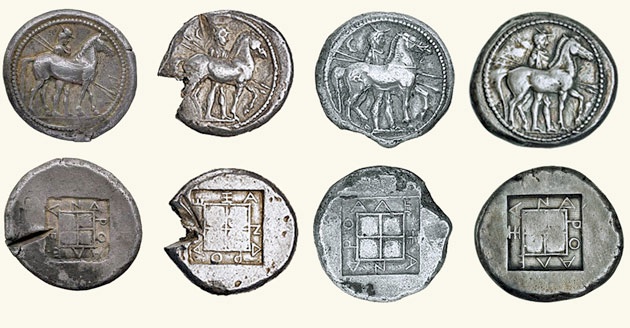
ANS 1977 158 136 ANS 1970 225 1 Kallet and Kroll (referenced below) ANS 2011 21 539
28.93 gm. 27.51 gm. (Figure 4.7, at p. 79) 24.231 gm. (?)
Alexander’s ‘signed standing horseman octadrachms:
Obverse: Standing horseman wearing a petasus , carrying two spears , standing behind his horse
Reverse: ΑΛΕΞΑΝΔΡΟ, surrounding a square divided by two crossed lines within an incuse square
The coins illustrated above include:
✴the three ‘signed standing horseman octadrachms’ in the ANS Mantis database; and
✴an interesting specimen illustrated by Lisa Kallet and John Kroll (referenced below, Figure 4.7, at p. 79), the obverse of which is similar to that of ANS 1970 225 1 (the coin to the left of it), insofar as both have a crescent behind the horseman’s head. On the ‘Kallet and Kroll’ specimen, the rump of the horse is branded with the symbol of a caduceus, and it is possible that this was also the case with ANS 1970 225 1.
Note that, although this obverse type was generally reserved for his ‘octadrachms’, the ANS database also contains examples of its use on two of his lower denomination coins (both of which also have a quadripartite square within incuse square on the reverse):
✴an ‘octobol’ (1944.100.12120, 4.05 gm.), with the inscription ΑΛΕΞΑΝΔΡΟ surrounding the quadripartite square; and
✴an anepigraphic ‘drachm’ (1944.100.11966, 3.88 gm.), which the ANS attribute to him.
The scant hoard evidence for Alexanders ‘standing horse octadrachms’ can be summarised as follows:
✴The catalogue by Colin Kraay and Peter Moorey (referenced below, 1968) of the 113 coins from the Jordan Hoard included a ‘horseman octadrachm’ (number 12) ‘signed’ by Alexander (alongside the two from this hoard ‘signed’ by the Bisaltae that were mentioned above).
✴Another single specimen (ANS 1970 225 1, illustrated above) came from the Asyut Hoard (catalogued as Asyut 152). As noted above, this hoard effectively ‘closed’ in ca. 475-470 BC, but Jonathan Kagan (in Ian Carradice (editor), referenced below, at pp. 22-3), who described this as a ‘troublesome coin’ in the context of the others from the hoard, argued that evidence from the ‘signed standing horse octadrachms’ of the Bisaltae in the Elmali hoard supported the contention of earlier scholars that the ‘neatly inscribed reverse’ on the ‘Asyut Alexander’ indicated that this coin:
“... is indeed likely to be substantially later than the bulk of that hoard.”
In other words although the hoard evidence points to a date before ca. 475-470 BC, stylistic evidence points to a date shortly before ca. 460 BC, the likely date of the less refined Bisaltian ‘octadrachms’ in the Elmali Hoard.
✴No coins of Alexander are known to have been in the Elmali hoard.
✴There are at least two references in the recent literature to the presence of Alexander’s ‘octadrachms’ in the Karkemish Hoard:
•Lisa Kallet and John Kroll (referenced below, at p. 156) noted that 5 ‘signed octadrachms’ of Alexander are thought to have been found in the Karkemish Hoard (along with the 9 similar coins signed by the Bisaltae and 30 anepigraphic coins of the same general type discussed above).
•Ute Wartenberg (referenced below, 2015, at p. 355, note 32):
“[While] there is no published die-study of the [‘octadrachms’ of Alexander I], ... the coins that appeared on the market as a result of the Karkemish and other hoards have illustrated that this is a very large series.”
However, I have been unable to establish whether these were of thee ‘standing horseman’ or the ‘mounted horseman’ type.
As noted above, Ute Wartenberg, referenced below, 2021, at p. 51) argued that:
“Since both the Elmali and the ‘Karkemish’ hoards contained [‘signed’ coins of Getas, king of the Edones while the earlier Asyut hoard did not], it seems likely that [Getas’] reign may be [dated] to ca. 465–450/40 BC. It thus falls into a similar period to the main output of Alexander I of Macedon and of the Bisaltae.”
Thraco-Macedonian ‘Standing Horseman Octadrachms’: Conclusions
The key facts from the hoard evidence discussed above are that:
✴no fewer than 68 freshly-minted ‘signed, standing horseman octadrachms’ of the Bisaltae were deposited in the Elmali Hoard shortly before it ‘closed’ in ca. 465 BC;
✴ a small number of these coins also appeared in the slightly later Karkemish Hoard, together with a number of derivatives:
•at least 30 anepigraphic types; and
•five 5 ‘signed octadrachms’ of Alexander (although some or all of these might have been of the ‘mounted horseman’ type discussed below); and
✴stylistic considerations suggest that the coins of the anepigraphic group formed a bridge between the Bisaltian and the regal types.
Based on this body of evidence, it seems that:
✴the Bisaltae produced an extraordinarily large issue of ‘signed standing horseman octadrachms‘ over a short period in ca. 465 BC;
✴this was followed in short order by series of increasingly refined derivatives that included:
•a large number of anepigraphic types issued by an unknown number of (presumably neighbouring) issuers; and then
•a type that Alexander ‘signed’ on the reverse.
We can also make some deductions about the relationship between Alexander and the Bisaltae at this time from the following surviving sources:
✴Herodotus recorded that, in 510 BC, when Persian envoys travelled to the court of Amyntas, Alexander’s father, to demand ‘earth and water’, they had started from Lake Prasias which would have been in the territory of the Bisaltae, and then passed
“... that mine from which Alexander later drew a daily revenue of a talent of silver”, (‘Persian Wars’, 5: 17: 2).
✴He also recorded that, during the Persian Wars of 484-480 BC:
“The [unnamed] Thracian king of the Bisaltae and the Crestonian country ... had told Xerxes that he would not willingly become his slave and had fled to the Rhodope Mountains”.
✴Finally, in his account of the events of 429 BC, Thucydides looked back on the way in which the Macedonians had come to dominate their neighbours, ending with the fact that they had:
“... also conquered places belonging to the other tribes, which are still theirs: Anthemus, Crestonia, Bisaltia and much of Macedonia proper. The whole is now called Macedonia ...”, (‘History of the Peloponnesian War’, 2: 99: 6).
It is usually assumed that Alexander had:
✴made his move into Bisaltian territory after its king had fled into Rhodope Mountains; and
✴retained control there when the Persians withdrew in 480 BC, albeit that the Bisaltae retained a degree of independence (as evidenced by their signed coinage of the 460s BC).
If this is correct, then it is possible that all of the ‘standing horseman octadrachms’ in the Elmali and Karkemish hoards had been produced using silver from the mine near Lake Prasias.
Finally, we should consider the significance of the ‘signed’ reverses on:
✴the Bisaltian ‘standing horseman octadrachm’ from the Black Sea Hoard;
✴the coin of the same type ‘signed’ by Mosses (CN type 4358); and
✴all of Alexander’s ‘signed octadrachms’.
As Margarita Tatscheva (referenced below, at p. 61) observed:
“The evolution of the reverse with the quadripartite square by its inclusion, together with the name of the [issuer], in an incuse square is observed in the issues of Alexander, Getas, the Bisaltae [and Mosses, as well as in the civic issues of] Acanthus and Abdera.”
She argued (at pp. 61-2) that:
“The [use] of the new inscribed reverse [type] ... most probably [began in] the mintsof the two cities. ... I believe that [the] popularity and prestige [of these issues led to the subsequent use of their reverse type] ... by the Bisaltae, Getas [see the previous section], Alexander and Mosses.”
As noted above, a few ‘signed two-oxen octadrachms’ of Getas, King of the Edones with the ‘new’ reverses were found in both the Elmali and the Karkemish hoards. This suggests (although it does not prove) that Getas inspired (rather than followed) the design of Alexander’s reverses. I suggest that a likely scenario is that:
✴Getas adopted the ‘new’ reverse type of Abdera for his ‘signed two oxen octadrachms’ at around the time of his success in depriving the Athenians of access to the mines of the Pangean Mountains; and
✴this new reverse was then swiftly adopted by
•the Bisaltae Mosses and Alexander (all of whom probably relied on the mine near Lake Praxias) for their ‘signed standing horseman octadrachms’; and also
•by Alexander for his ‘mounted standing horseman octadrachms’ (see below).
t
t
Alexander’s ‘Mounted Horseman’ Obverses

‘Octadrachm’ (ANS 1967 152 190 = Doris Raymond, referenced below, at p, 79, coin 6); 27.84 gm)
Obverse: mounted horseman wearing a chlamys and petasus and carrying two spears
Reverse: ΑΛΕΞΑΝΔΡΟ, surrounding a quadripartite square within an incuse square
Doris Raymond (referenced below) catalogued ten ‘octadrachms’ of the ‘mounted horseman’ type, all of which were ‘signed’ by Alexander. She split them into two groups on the basis of her estimation of their dates:
Raymond Group I (ca. 480 - 476 BC): coins 1-6 (at pp. 78-9 and Plate III); and
Raymond Group III (ca. 460 - 451 BC): coins 108-11 (at p.126 and Plate X).
which was also discussed above) is one of three ‘signed octadrachms’ of this obverse type that are catalogued in the ANS Mantis database: the other two are catalogued as ANS 1954 98 1 (28.44 gm.) and ANS 1960 176 4 (28.08 gm; note that the reverse illustrated in the entry for this third coin is apparently anepigraphic, although the description of it included the inscription ΑΛΕΞΑΝΔΡΟ).
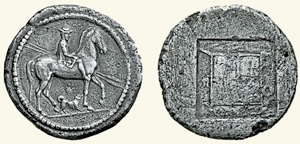
An example a rare type of these coins in the collection of Alpha Bank , Greece (collection ref. no.: 1218, 26.96 gm.) depicts a domesticated dog walking next to the horse, which seems to suggest that horseman was not intended to be seen as a military figure.
This obverse was also used for all of Alexander’s tetradrachms, although, as Talia Knowles (referenced below, at p. 19) observed:
“Minor stylistic flourishes distinguish different series or issues. These include a dotted or linear border, or the inscription ‘A’ on or above the exergual line.”
She also noted that, unlike the reverse type used on the ‘octadrachms’, which, as we have seen, always involve a four-part incuse square (either anepigraphic or ‘signed’), that used the tetradrachms:
“... varies greatly. According to ... [the chronological] order of issues [proposed by Doris Raymond, referenced below], Alexander’s reverse type progresses from:
✴a four-part incuse square; to
✴a goat head; to
✴a crested helmet; to
✴a goat forepart; to
✴a goat forepart with the inscription ΑΛΕ; to
✴a goat forepart with its head reverted.”
Finally, the ‘mounted horseman‘ appears on three of Alexander’s ‘tetrobols’, the types of which are distinguished by their reverses:
✴one (ANS 1944 100 11967, 2,46 gm.) used a four-part incuse square; and
✴two used the eead and leg of lion in an incuse square:
•one (ANS 1944 100 12121, 2.29 gm.) anepigraphic; and
•the other (ANS 1983 10 1, 1.96 gm., damaged) signed ΑΛΕΞΑΝΔOΟ (sic).
Alexander’s Earliest Known Coin (?)
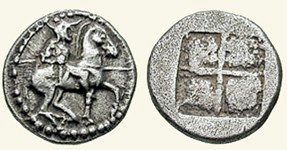
Tetrobol (2.38 gm.) attributed to Alexander
Obverse: Mounted horseman wearing a petasus (wide-brimmed hat) and armour, armed with a spear in this left hand and what is probably a Persian akinakes (short sword) in this right hand
Reverse: Quadripartite square within an incuse square
Image: CNG 60 (22 May 2002), lot 250
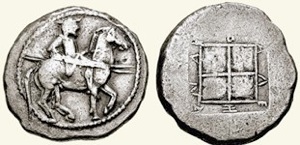
‘Signed mounted horseman octadrachm’ of Alexander (29.75gm.)
Obverse: Mounted horseman wearing chlamys (cloak) and petasos, and holding two spears in his right hand
Reverse: ΑΛΕΞΑΝΔΡΟ: inscription surrounding a quadripartite square within an incuse square
Image: CNG 60 (10 January 2005), lot 132
Text to follow
Heinrichs J. and Müller S, “Ein Persisches Statussymbol auf Münzen Alexanders I von Makedonien”, Zeitschrift für Papyrologie und Epigraphik, 167 (2008) 283–309
Alexander’s Goat Reverses
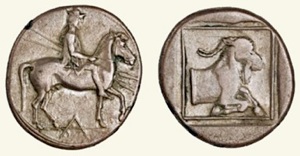
Silver tetradrachm (ANS 1963 268 40) assigned to Alexander
Obverse: Mounted horseman carrying two spears
Reverse: Incuse square containing forepart of a goat
Euripides (who was writing in the reign of the historical Archelaus) might have included this information, but,
Alexander’s Lion Reverses

Tetrobol (ANS 1983 10 1) assigned to Alexander I
Obverse: Mounted horseman carrying two spears
Reverse: ΑΛΕΞΑΝΔOΟ (sic): Lion forepart in incuse square
Alexander himself presumably appreciated Herodotus’ testimony of his ‘Greekness’. However, he would also surely have also appreciated the dynastic value of Thucydides’ testimony of his descent from Heracles (via Temenus and Perdiccas I), as evidenced by the fact that he:
✴depicted what was arguably the Nemean lion that Heracles had killed on the reverse of a signed tetrobol (illustrated above; and
✴named his first-born son Perdiccas.
Since Philip is likely to have used his early silver coinage as a vehicle for establishing the continuity of Argead rule, and hence for his own legitimacy, we would expect him to draw on the iconography used in the coinage of his predecessors. I therefore begin by looking at these precedents.
Hermes
They illustrated (at p. 79, Figure 4.7) an octadrachm (= tristater) of this kind that was ‘signed’ on the reverse by Alexander I, on which the rump of the horse was branded with a caduceus.
Variants of these ‘signed’ types are known in which the rump of the horse was ‘branded’. For example:
•Catharine Lorber also illustrated one (as coin B in her Plate 14) in which the horse was ‘branded’ with the monogram AΛ (which she interpreted as a reference to Alexander I).
•Doris Raymond catalogued another (at (Plate II, 2) in which the horse was ‘branded’ with the monogram ‘EM’: this coin is also illustrated by
-Mike Markowitz (referenced below, at p. 1) and
-on this page of the Classical Numismatic Group)
✴Anepigraphic coins of this type that are attributed to the Bisaltae in the CN database include:
•an octadrachm (CN type 4206); and
•a number of coins of lower denomination (see notes 17-20 in the main page of the database).
Lisa Kallet and John Kroll (referenced below, at p. 79, Figure 4.6) illustrated an anepigraphic version of this type that they attributed to the Bisaltae, in which the rump of the horse was branded with a caduceus, which is generally an attribute of the god known to the Greeks as Hermes
The on-line ‘MANTIS’ catalogue of the coins in the collection of the American Numismatic Society (ANS) contains 51 silver coins that are assigned to Alexander, who was the first Macedonian king to issue coins in his own name. Since the precise denominations assigned to these coins are somewhat contentious, I have sorted the list by weight, which allows us to isolate three clearly differentiated groups:
✴The 7 in the weight range 28.93 - 27.51 gm. are all classified in this database as octadrachms (along with an 8th weighing 24.23 gm. (which might be a typo) and a 9th that is is fragmentary and possibly mis-assigned). The lower denominations can be assigned to one of two groups on the basis of weight;
•the 16 in the weight range 13.20 - 11.02 gm. are classified as tetradrachms; and
•the coins assigned to lower denominations (apart from two staters that were minted at Tarentum and should probably be re-assigned to Alexander I of Molossia) all weigh 4.05 gm or less.
It is possible that this development also occurred elsewhere in the region: for example, the ANS Mantis database contains two anepigraphic ‘tetrobols’ with rough incuse square reverses that it assigns to Bisaltae:
✴one (ANS 1965 242 1, 2.66 gm.) that depicts a mounted horseman, possibly wearing a petasus and certainly carrying two spears; and
✴another (ANS 1960 170 80, 2.37 gm.) that depicts a mounted horseman, probably wearing a petasus, at the moment that his horse decides to kneel on the ground (see below)
Sławomir Sprawski (referenced below, at p. 26) pointed out that these and the other:
“... motifs that appear on Alexander’s coinages were selected from among already-existing types. Even if the decisions to choose them were dictated mainly by practical reasons, specific types always carried a symbolic meaning. [For example], a horseman wearing a petasus, which is one of the most consistently used motifs in the coinage of the Argeadae, ... [also] appears on the coinages of the Thraco-Macedonian tribes, [where] it was interpreted as an image of the Thracian hero Rhesos ... Newer research shows that the horseman motif was borrowed from Poteidaia and Sermylia, Greek cities on the Chalcidic peninsula. ... However, on most coinages, the horseman is equipped for hunting, not for fighting. It seems, therefore, that we are more likely dealing with a hunting scene, and this is what the images of lions on the reverses of some types may be alluding to. Much has been written about the significance of hunting for Macedonian kings and aristocracy, and the choice of this motif seems to fit well with the world of values they shared. If Alexander wanted to build his image and prestige through the motif placed on his coinages, then he was alluding not to his descent but to the values associated with hunting.”
However, it is worth looking further at the iconography of Rhesus before pronouncing on its potential significance for Alexander’s ‘horseman’ obverses. Vaios Liapis (referenced below, 2011, at p. 95) observed that the fragmentary surviving evidence:
“... suggests that the cult of Rhesus ... was indigenous to ancient Macedonia and Thrace.”
He went on (at p. 104) to identify a number of traits that Rhesus shared with the so-called Heros Equitans (or Thracian Horseman), who:
“... is always depicted as a horseman, with further variations including .., as:
✴a hunter;
✴a healer;
✴a cult figure, associated with sacrificial ritual or with the chthonic realm; or
✴a warrior.
This relatively limited range of iconographic motifs and attributes is consistent with the hypothesis that the Heros Equitans represents a single figure of cult rather than a plurality of divinities who simply happen to be depicted, more or less often, as riders. This hypothesis is considerably corroborated by the observation, substantiated in the preceding discussion, that the basic iconographic attributes of the Heros Equitans are typically associated, in myth or cult, with Rhesus.”
It therefore seems to me that, even if the iconography of Rhesus/ Heros Equitans was already established by the time of Alexander, there was nothing to prevent Alexander from adapting it in order to portray his horseman as a warrior. (I discuss the more likely significance of the lion reverses below).
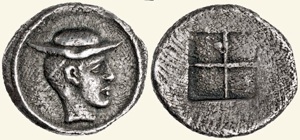
Silver obol attributed to Alexander I (ANS 1944.100.12137)
Obverse: Head of a young man wearing petasus
Reverse: Quadripartite incuse square
In the present context, it is interesting to note that the only one of the 47 silver coins assigned to Alexander in the catalogue that does not feature a horse (i.e., the obol illustrated above, assuming that it is correctly assigned) features instead a young man similarly wearing a petasus. This suggests to me that he is the same man as the horseman under discussion here, and that this horseman represented a particular Macedonian, perhaps Alexander himself, but more probably, the ancestor from whom he received the right to the Macedonian throne. (Note, however, that Dimitrios Gerothanasis, referenced below, at p. 355, note 10 and figure 3, illustrated in this page of the Classical Numismatic Group) recorded a very similar obverse on a coin (late 5th century BC) from Kapsa on the Chalcidice peninsula, which he described as:
“... a unicum diobol (if correctly attributed) depicting:
✴a Hermes head to the right on the obverse; and
✴a lekythos on the reverse, along with the ... inscription ‘K-A’”. This coin
Perdiccas II and his Homonymous Ancestor
As noted above, Alexander was already acting as heir apparent when his father, Amyntas, died shortly after 500 BC. It is not known whether he had any surviving brothers at that time but, if so, they do not seem to have impeded his smooth succession. However, the situation when Alexander himself died in ca. 454 BC was more complicated, because, as Selene Psoma (referenced below, at p. 16) pointed out, he had at least five sons:
✴four of them (Perdiccas, Philip, Alcetas and Amyntas) were named for one of the Alexander’s predecessor (actual or invented); and
✴at least three of them (Perdicass, then king as Perdiccas II, Alcetas and Menelaus), appear at the start of the list of the 85 oath-takers in a treaty (IG I³ 89; 60-1) between Perdiccas II and Athens (of uncertain date):
•Περ̣δ̣ίκκας [Ἀλεχσάνδρο] (Perdiccas, [son of Alexander]);
•Ἀλκέτες Ἀλεχσάνδρο (Alcetas, son of Alexander);
•Ἀρχέλας Π̣[ερδίκκο] (Archelaus, son of P[erdiccas]);
•[29 missing letters, possibly naming another two sons of Alexander],
•Με̣νέ̣λαος Ἀλεχσά̣[νδρ]ο (Menelaus, son of Alexa[nder]);
•Ἀγέλαος Ἀ[λκέτο (Agelaus, son of A[lectas]) ...
As noted above, according to Thucydides, in 413 BC:
“When Archelaus, son of Perdiccas [II], became king, he ... organised his country for war by providing cavalry, arms and other equipment beyond anything achieved by all the eight kings who preceded him”, (‘History of the Peloponnesian War’, 2: 100: 2, translated by Charles Smith, referenced below, 1919, at p. 453).
This seems to suggest unbroken father-to-son succession:
Alexander (7th after Perdiccas I)
Perdicas II (8th after Perdiccas I)
Archelaus (9th after Perdiccas I)
However, as Carol King (referenced below, at p. 34) pointed out:
“Although we should expect Perdiccas [II] to have succeeded Alexander in ca. 454 BC. he does not appear on the historical scene until the mid 430s BC, when he is found defending his throne against his brother, Philip, and Philip’s son, Amytas. What troubles occurred with the kingship in the intervening two decades is a mystery with few clues. ... [It seems that at least three of the brothers (Perdiccas, Philip and Alcetas) fought for control of at least parts the territory that had been ruled by their father] but that, by the mid 430s BC, Perdiccas had sole title to the kingship
Archelaus and his Homonymous Ancestor
The table above indicates the long chronological gap of some 10 generations between:
✴the Heraclid Temenus of Argos; and
✴Perdiccas ‘of the line of Temenus’, the first name tin what had probably been the ‘official’ Macedonian king list in the mid 5th century BC.
This left ample room for the insertion of earlier putative Macedonian founders: for example, as Mait Kõiv (referenced below, at p. 267) observed:
“... in the tragedy ‘Archelaus’ by Euripides, composed in the Macedonian court during the late 5th century, the founder of the Macedonian dynasty was called Archelaus and described as the son [sic] of Temenus. [This mythical] Archelaus must, [therefore], have arrived at Macedonia almost at the time of the Dorian invasion. The versions of Herodotus and Euripides thus clearly disagreed concerning both:
✴the name of the dynasty founder (Perdiccas versus Archelaus, son [sic] of Temenus); and
✴the date of the foundation.”
Only fragments of the ‘Archelaus’ survive, but we know from one of them that its subject, the mythical Archelaus, explained to the audience (probably at the start of the play) that he was descended from Heracles, via Temenus:
“Heracles fathered Hyllus, and Hyllus fathered Temenus, who resettled Argos, being from Heracles’ stock. However, Temenus ... was without offspring, so he went to holy Dodona’s vales in his desire for children; and the priestess of [Dodona] ... [addressed him as Temenus, son of Heracles’ stock and told him:
‘... that Zeus will give a son to you whom you must call Archelaus’”, (‘Archelaus’, Fragment 228a: 17, translated by Christopher Collard and Martin Cropp, (referenced below, 2014, at p. 238)
Eoghan Moloney (referenced below, at p. 238) argued that, although the lineage from Heracles to Hyllus:
“... was traditionally accepted prior to the ‘Archelaus’, ... Euripides [probably introduced] two new elements:
✴he listed Temenus as the son of Hyllus; and then
✴he [almost certainly] established the mythical Archelaus as the son of Temenus, a birth prophesied by the priestess of Dodona, ... [which] completed the early history of the Macedonian royal line.”
Alexandros Velaoras (referenced below, at pp. 305-6) agreed that:
“Archelaus, son of Temenus, is very likely to have been, at least in part, a Euripidean invention, as he is not attested in other authors previously. The 37 extant fragments [of the play], by themselves, do not permit a reconstruction of the plot: this is only possible with Hyginus’ ‘Fabulae’, 219”
This passage from Hyginus has been translated as follows:
“Archelaus, son of Temenus, when driven into exile by his brothers, he came to King Cisseus in Thrace. Since he was descended from Heracles ... [Cisseus], who was under siege by his neighbours, promised to give him his kingdom and his daughter in marriage, if he would protect him from his enemies. After Archelaus had put the enemy to flight in one battle, [Cisseus made plans to kill him]. ... When Archelaus learned of this, ... [he killed Cisseus and] then, in accordance with an oracular response of Apollo, he fled from Thrace to Macedonia, with a goat leading him, and founded a town called Aegeae from the name of the goat”, (‘Fabulae’, 219).
Edmund Stewart (referenced below, p. 87, at note 40) reasonably argued that:
“... it is likely that Euripides was Hyginus’ only source, [since]:
✴he shows no awareness of the alternative myths surrounding the Temenidae; and
✴most importantly, he uses the name Archelaus, which is found in no other source.”
Alexandros Velaoras (referenced below, in his abstract at p. 303) agreed that:
“... was probably written for the Macedonian king Archelaus, [the son of Perdiccas II], during Euripides’ stay in Macedonia in the last years of his life and publicly performed at Dium in 408/407 BC.”
Plato (in an imagined dialogue between Socrates and the young Polus) has Polus observe that Archelaus I:
“... had no claim to the [Macedonian] throne, which he now occupies, being the son of a woman who was a slave of Perdiccas’ brother Alcetas and, ... if he wished to do what is just, he would be serving Alcetas ... [Instead] he has done the most enormous wrong:
✴First, he invited ... [Alcetas] to his court, pretending that he was going to restore to him the kingdom of which Perdiccas had deprived him; but instead, after entertaining him and his son Alexander ... and making them drunk, he ... murdered and made away with both of them.
✴[Then] ... he refused to raise his brother, the legitimate son of Perdiccas, a boy about 7 years old. who had a just title to the throne, and to restore the kingdom to him; but rather, he cast him into a well and drowned him, and then told his mother Cleopatra that he had fallen in and lost his life while chasing a goose”, (‘Gorgias’, 471. translated by Walter Lamb, referenced below, at pp. 341-3)
Caranus
According to a scholiast on the ‘Protrepticus’ of Clement of Alexandria (in his gloss on ‘Goats’):
“When Caranus, son of Poanthes, was about to send a colony from Argos to Macedonia, he went to consult the oracle at Delphi, Apollo, who prophesied as follows:
‘Reflect, god-like Caranus, and take my words to heart: Leave Argos and Hellas, the land of beautiful women, and go to the sources of the Haliacmon; it is fated for you to settle there, where you first set eyes on grazing goats ...’
Encouraged by the oracle and accompanied by certain Greeks, Caranus sent out his colony and, arriving in Macedonia, founded a city. He ruled over the Macedonians and re-named the city (formerly known as Edessa) as Aegae, after the goats (aiges). Edessa was formerly inhabited by Phrygians and Lydians and those who crossed over into Europe along with Midas. These things are mentioned by Euphorion in the ‘Histia’ and ‘Inachus’”, (translated as a fragment of Euphorion’s ‘Istia’ by Jane Lightfoot, referenced below, at p. 265).
Thus:
✴ww can trace the myth of Caranus’ foundation of Aegae and its association with goats back to Euphorion (3rd century BC) and
✴the longevity of the tradition is evidenced by the fact that a version of it was preserved by Justinus, in his ‘Epitome of Pompeius Trogus' Philippic Histories’, 7: 7), as well as by the scholiast.
Eusebius:
“This Caranus was the 11th from Heracles and . . . the 7th from Temenus. His genealogy is given by Diodorus [7: 17] and most of the historians (one of whom is Theopompus) as follows:
Caranus, son of Pheidon, son of Aristodamides, son of Merops, son of Thestius, son of Cissius, son of Temenus, son of Aristomachus, son of Cleadates, son of Hyllus, son of Heracles”
Perdiccas II treaty (IG I³ 89; 60-1)
Περ̣δ̣ίκκας [Ἀλεχσάνδρο], Ἀλκέτες Ἀλεχσάνδρο, Ἀρχέλας Π̣[ερδίκκο, ․․․․․․․․․․23․․․․․․․․․․․]
[․․6․․․], Με̣νέ̣λαος Ἀλεχσά̣[νδρ]ο, Ἀγέλαος Ἀ[λκέτο
Perdiccas, [son of Alexander]; Alcetas, son of Alexander; Archelaus, son of P[erdiccas] ...
... Menelaus, son of Alexa[nder]; Agelaus, son of A[lectas] ...
Perdiccas II (454 - 413 BC)
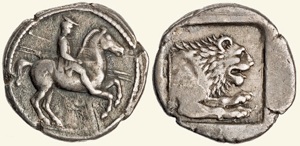
Tetrobol (ANS 1944 100 12142) assigned to Perdiccas II
Obverse: Mounted horseman carrying two spears
Reverse: Lion forepart in incuse square
As Sławomir Sprawski (referenced below, 2021, at pp, 25-6) observed:
“The coinage of Alexander’s son, who succeeded him as Perdiccas II, was much more modest [than that of Alexander himself]. During his long reign, he only struck coinages of low denominations (tetrobols and obols) and they bore images that had appeared on his father’s coins, although in a smaller selection:
✴on the [diobols], he placed:
•a horse on the obverse; and
•a crested helmet on the reverse; and
✴on the ... tetrobols, he placed:
•a horseman in a petasus holding two spears on the obverse ; and
•a lion’s protome on the reverse.”
Barclay Head (referenced below, at p. 162) published a ‘signed’ version of each of these types:
✴Number 1 (which was the heavier of the two) had:
•Obverse: Horse prancing; and
•Reverse: ΠΕΡΔΙΚ (of Perdicc(us)):Helmet in an incuse square.
The ANS Mantis database contains four tetrobols of this type.
✴Number 2 had:
•Obverse: Horse fastened to ring; and
•Reverse: [Π]ΕΡ: Forepart of lion in an incuse square.
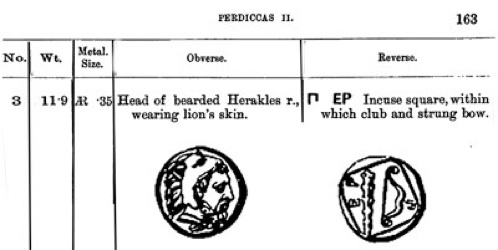
Entry in the catalogue published by Barclay Head (referenced below, at p. 163)
Obverse: bearded Heracles, wearing a lion skin headdress (presumably been taken from the Nemean lion)
Reverse: ΠΕΡ: Club and bow (attributes of Heracles) in an incuse square
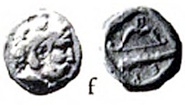
Image of the coin above (from Doris Raymond, referenced below, Plate XI, f)
However, the last ‘signed’ coin in this section (number 3, at p. 163, illustrated above), which was also the lightest, is more important, because of the appearance of Heracles on the obverse. Doris Raymond (referenced below, at p. 46) observed that ‘Herculean’ coinage had been quite wide-spread in tribal issues from at least the 6th century BC. However, the coin type under discussion here constitutes Hercules’ first appearance on an issue by a Macedonian king. Doris Raymond (referenced below, at p.164) observed that, in view of the legend:
“... ПEP on the reverse, [clockwise from above the bow], there can be no doubt about [its assignment to Perdiccas II]. ... The choice of the Heraclean type can easily be justified by the Argive ancestry of the Macedonian kings, here for the first time clearly marked on [their] coins.”
As this extract from ANS Mantis database of Macedonian coins with the bust of Hercules (bearded or unbearded) wearing a lion skin headdress illustrates how successive kings from Archelaus (Perdiccas’ son) to Alexander the Great embraced Perdiccas’ one numismatic innovation.
Archelaus I (413 - 399 BC)
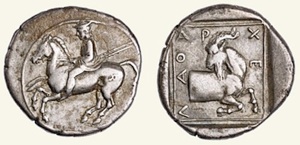
Silver didrachm (ANS 1970 94 1)
Obverse: galloping horseman with two spears
Reverse: ΑΡXΕΛΑΟ): Forepart of a goat moving right, head reverted
Thucydides (following his account of Sitalces’ invasion of Macedonia touched on above) observed that, under Perdiccas II:
“The Macedonians, ... [since they were] unable to defend themselves against so great an invading army, retreated to the few fortified places and fortresses that were in the country. ... However, when Archelaus, the son of Perdiccas, became king, he:
✴built [the fortesses] that are now in the country;
✴cut straight roads; and
✴... organised his country for war by providing cavalry, arms and other equipment beyond anything achieved by all the eight kings who had preceded him”, (“History of the Peloponnesian War”, 2: 100, translated by Charles Smith, 1919, at p. 453).
As we shall see, he also greatly enhanced the cultural life of Macedonia, not least by attracting Greek painters and poets to his court. However, for our purposes, the most important thing about him was the major innovations that he made to the established iconography of the Argead coinage.
The ANS Mantis catalogue contains 18 known examples of Archelaus’ coins, all of which are made of silver, 16 of which have the reverse legend ΑΡXΕΛΑΟ (of Archelaus, sometimes abbreviated). These coins are classified by denomination as follows:
✴Didrachms:
•Two types are known:
-Obverse: Head of Apollo [see below], wearing taenia; and
-Reverse: ΑΡXΕΛΑΟ: Standing horse with trailing bridle;
•and the other (illustrated and discussed below):
-Obverse: Galloping horseman, carrying two spears; and
-Reverse: ΑΡXΕΛΑΟ: Forepart of a goat (illustrated above).
✴Diobols:
•Obverse: Prancing horse; and
•Reverse: ΑΡXΕΛΑΟ: Crested helmet.
✴Obols:
•Obverse: Bearded head of Heracles wearing a lion skin headdress; and
•Reverse: ΑΡX: Forepart of a wolf devouring prey; club above.
✴ Fractions:
•Obverse: Male head; and
•Reverse: No inscription: Forepart of a boar.
✴Quarter Obols:
•Obverse: Beardless head of Heracles wearing lion skin headdress; and
•Reverse: ΑΡ: Head of a lion; club above.
The most important iconographic innovation here was Archelaus’ introduction of the bust of deities to the obverses of his coin:
✴the head of a young man usually identified as Apollo (as in the ANS catalogue) graced some of his didrachms; and
✴the head of Heracles (unmistakeable because of his lion skin headdress) appears:
•bearded, on his obols, where it is paired with a wolf devouring prey, with what was presumably Heracles’ club above; and
•beardless, on his quarter obols, where it is paired with the head of what was presumably the Nemean lion that Heracles had killed, and again with what was presumably Heracles’ club above.
If we leave ‘Apollo’ to one side for a moment, these other iconographic changes seem to amplify the Argead claim of descent from Heracles.
Archelaus and Euripides
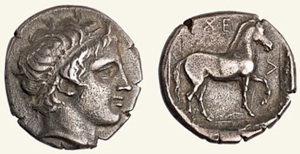
Silver didrachm (ANS 1944 100 12150)
Obverse: Head of Apollo, wearing taenia
Reverse: ΑΡXΕΛΑΟ: standing horse
We should now look at the Archelaus’ didrachm type exemplified by ANS 1970 94 1 (illustrated above). I have to say that the description of the goat given in the catalogue is anatomically impossible. I think that the reverse depicts the rear of the horse of the obverse, being pushed by a goat (of which only the forepart is depicted). If so, then the galloping horseman on the obverse would be the mythical Archelaus, en route from Thrace top Macedonia on the advice of an oracle of Apollo.
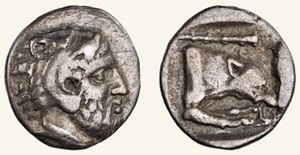
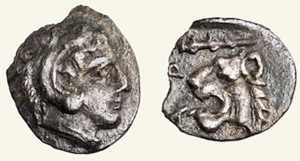
Silver obol (ANS 1944 100 12154) Silver quarter obol (ANS 1963 268 52)
Obverse: Bearded head of Heracles covered by lion skin Obverse: Beardless head Heracles covered by lion skin
Reverse: APX: forepart of wolf devouring prey, club above Reverse: ΑΡXΕΛΑΟ: Lion’s head, club above
It is unsurprising that the historic Archelaus should take advantage of his newly-discovered decent from Heracles in his coinage. The appropriate iconography would have been easily to hand: as Elton Baker and Joel P. Christensen (referenced below, at note 17) observed:
“According to the Suda (s.v Peisandros), the Rhodian Peisander, who flourished in the 7th century BC, wrote about the ;deeds of Heracles’ in two books (and was the first to give him a club). Two extant fragments of [the epic poet] Panyasis ... bestow a lion skin upon the hero.”
(These fragments are translated by Martin West, referenced below, as fragments 6, ad 7, at p, 197).
Reflections of Herodotus ?
The wolf head on the reverse of Archelaus’ obol is very similar to that on contemporary coins from Argos (see this example of a silver triobal from Argos, which is now in the Metropolitan Museum, New York). Thus, it seems that Archelaus was keen to reflect Herodotus’ account of his descent from Temenus of Argos.
This brings us to the young man wearing a tainia (headband) on some of Archelaus’ didrachms whom ANS identify as Apollo, an identification that is sometimes disputed. It seems to me that this identification is almost certain, since, as Christopher Witmore (referenced below, at p. 275) observed:
“In the ... sanctuary of Apollo Lycius [at Argos], a [statue] portrayed a wolf attacking a bull outside Argos at a time when Danaus, [a mythical king of Argos], sought refuge [see Plutarch, ‘Life of Pyrrhus’, 32: 4-5 and Pausanias, ‘Description of Greece’, : 19: 3-4). Having correctly interpreted this as an omen, Danaus paid his vows to Apollo Lycius and won the kingdom of Argos by force. The association with the wolf was fundamental to Apollo, protector of the city, and thus to Argos. This special relationship of Argos, Apollo and wolf was mobilised in, [for example], the ‘Wolf A’ coinage of the polis, which dates to the late 4th/ mid-3rd centuries BC.”
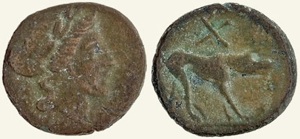
Bronze coin (ANS 1927 131 293) from Argos
Obverse: Head of a young man identified in the catalogue as Apollo
Reverse: Wolf (with what might be crossed clubs above)
Interestingly, although the wolf, paired with a reverse of an ‘A’ within a square frame, appears in the silver and bronze coinage of Argos, it also appears in the bronze coinage paired with Apollo (as in the example illustrated above). It seems to me that:
✴the young man whose head appears on these bronze coins from Argos is the same young man who is depicted in the same way on some of Archelaus’ didrachms; and
✴he should most probably be identified as Apollo Lycius.
Having said that, the actual design for Philip’s putative Apollo might have been taken from a design that was already in use for obols at Amphipolis (where the reverses all depicted a fish).
Philip’s Coinage
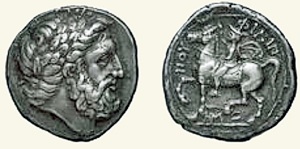
Silver tetradrachm (PELLA: Philip II 7, 359-348 BC)
Obverse: Laureate head of Zeus
Reverse: ΦΙΛΙΠΠΟΥ : Philip II [sic] on horseback, wearing causia, tunic and chlamys
Until recently, historians of Philip’s reign have been hampered by the lack of a systematic study of Philip’s coinage (see, for example, the observations of Martin Price, referenced below, 1974, at p. 21-2). This problem was remedied to an extent by Georges le Rider (referenced below), although, as Martin Price (in his paper of 1979, referenced below) demonstrated, Le Rider’s chronology was by no means definitive. Fortunately, the American Numismatic Society (ANS) has recently published a new and searchable catalogue (‘PELLA’) of:
“... the coinages struck by the Macedonian kings of the Argead dynasty (ca. 700–310 BC), arguably the most influential coinages of the ancient Greek world.”
This new catalogue, which covers the coins in 19 major collections, starts with the coinage of Philip II.
The new PELLA catalogue contains 63 known examples of Philip’s gold and silver coinage, each of which bears the reverse inscription ΦΙΛΙΠΠΟΥ (of Philip) and is assigned to one of two mints:
✴Pella (Philip’s capitol); or
✴Amphipolis (which, as we have seen, fell into his hands in 358 BC).
50 of these coins are dated to the period before 348 BC: they are all made from silver and can be classified by denomination as follows:
✴Tetradrachms:
•assigned to both Pella and Amphipolis:
-Obverse: Laurate head of Zeus to right; and
-Reverse: ΦΙΛΙΠΠΟΥ: ‘Philip II’ wearing causia, tunic and chlamys riding horse to left.
✴Didrachms: assigned to both Pella and Amphipolis:
•Obverse: Head of beardless Heracles right wearing lion skin headdress; and
•Reverse: ΦΙΛΙΠΠΟΥ: ‘Philip II’ wearing causia, tunic and chlamys riding horse to left.
✴Drachms:
•assigned to Pella:
-Obverse: Head of beardless Heracles right wearing lion skin headdress; and
-Reverse: ΦΙΛΙΠΠΟΥ: Nude youth riding horse to left, reins in right hand, victory palm in left hand.
•assigned to Amphipolis:
-Obverse: Head of beardless Heracles right wearing lion skin headdress; and
-Reverse: ΦΙΛΙΠΠΟΥ: ‘Philip II’ wearing causia, tunic and chlamys riding horse to left.
✴Hemidrachms:
•assigned to Pella:
-Obverse: Head of youth to right, hair tied with strophion; and
-Reverse: ΦΙΛΙΠΠΟΥ: Nude youth riding horse to left, reins in right hand, victory palm in left hand.
•assigned to Pella:
-Obverse: Laurate head of Apollo to right; and
-Reverse: ΦΙΛΙΠΠΟΥ: ‘Philip II’ wearing causia, tunic and chlamys riding horse to left.
•assigned to Amphipolis:
-Obverse: Head of youth to right, hair tied with strophion; and
-Reverse: ΦΙΛΙΠΠΟΥ: ‘Philip II’ wearing causia, tunic and chlamys riding horse to left.
✴Tetrobols:
•assigned to Pella:
-Obverse: Laurate head of Apollo to right; and
-Reverse: ΦΙΛΙΠΠΟΥ: ‘Philip II’ wearing causia, tunic and chlamys riding horse to left.
Iconography taken from Archelaus (?)
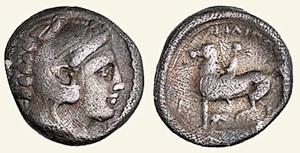
Drachm (3.37 gm.) of Philip II (357 - 348 BC), assigned to the mint at Amphipolis
Obverse: Head of beardless Heracles right wearing lion skin headdress
Reverse: ΦΙΛΙΠΠΟΥ: Philip II [?] on horseback, wearing causia, tunic and chlamys
Image: PELLA Philip II 101
As we have seen, Archelaus had advertised his descent from Heracles by using depicting his ancestor both bearded and beardless, but always wearing his lion skin headdress. Philip presumably chose the beardless type for some of his didrachms and all of his drachms because of his relative youth.
The reverse type used on the drachm illustrated above is also used on almost all of Philip’s early coins (with the exceptions discussed below among his apparent innovations). The catalogue identifies the man on horseback as Philip himself but, as I argue above, he is, in my view, more likely to represent Philip’s mythical ancestor, Archelaus (a descendant of Heracles) en route from Thrace to Macedonia.
Hemidrachm of Philip II (PELLA Philip II 2, 357 - 348 BC), assigned to the mint at Amphipolis
Obverse: Head of youth looking to the right, hair tied with ‘strophion’ (head band, more usually given as ‘tainia’)
Reverse: ΦΙΛΙΠΠΟΥ: Nude youth riding horse to left, carrying victory palm (see the section of Philip’s innovations)
The young man whose head is depicted in the obverses of some of Philip’s early hemidrachms (including PELLA Philip II 2, illustrated above) is left anonymous in the catalogue. However, the similar image on each of the obverses of:
✴another of the hemidrachms (including PELLA Philip II 30) and
✴the tetrobols (including PELLA Philip II 29);
is identified in the catalogue as the laurate head of Apollo. (Unfortunately, no images of them are included, although an example of the tetrobol that might be from a slightly later period is illustrated in this page from the British Museum.) On the basis of the analysis of Archelaus’ coins above, the heads on all of Philip’s early hemidrachms and tetrabols should probably be identified as those of Apollo Lycius.
Philip’s Innovations
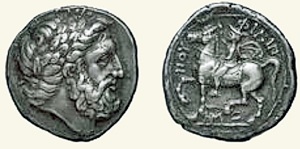

Silver tetradrachm (14.15 gm,: 359-348 BC) Silver stater (12.14 gm.; 360-350 BC)
Mint: Pella Mint: Elis
Obverse: Laureate head of Zeus Obverse: Laureate head of Zeus
Reverse: ΦΙΛΙΠΠΟΥ : Philip II [?] on horseback, Reverse: F - A (= FΑΛΕOΝ, the people of Elis):
wearing causia, tunic and chlamys eagle on Ionian capital
Image: PELLA: Philip II 7 Image: ANS 1994 100 37750
Philip introduced the head of the laureate Zeus to the coinage of Macedonia when he used it for his early tetradrachms. The image of Zeus on these coins is extraordinarily refined and might well have been inspired by the similar obverses that had recently been struck at Elis for the 105th Olympiad in 360 BC:
✴one of these Olympian images is on the stater illustrated above on the right; and
✴another is illustrated on a (now rare) tetradrachm that was minted on the same occasion and at the same mint and recently auctioned by the Classical Numismatic Group.
If this is correct, then Philip’s early tetradrachms combined Olympian Zeus with his mythical ancestor, Archelaus of Argos.
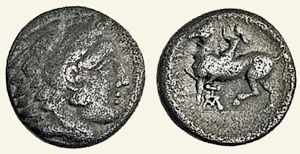
Drachm of Philip II (3.3 gm.; 357 - 348 BC), assigned to the mint at Pella
Obverse: Head of beardless Heracles right wearing lion skin headdress
Reverse: ΦΙΛΙΠΠΟΥ (of Philip): Nude youth on horseback, holding a victory palm in left hand
Image: PELLA Philip II 10
As noted above, Plutarch recorded that one of Philip’s horses won at the keles (horse race) at the Olympic games of 356 BC (the 107th Olympiad). This victory is generally assumed to have been commemorated in another of Philips numismatic innovations: the reverses type used on:
✴some of his drachms (including PELLA Philip II 10, illustrated above); and
✴his hemidrachms (including PELLA Philip II 2, illustrated above).
Philip’s Coinage: Conclusions
Philip’s early silver coinage can be classified in terms of the deities depicted on the obverses of the component denominations:
✴Zeus (probably Olympian Zeus): tetradrachms:
✴Heracles: didrachms and drachms; and
✴Apollo (in my view, probably Apollo Lycius): hemidrachms and tetrobols.
The mounted horseman wearing wearing causia, tunic and chlamys who graced the reverses of most of these coins in my view represented the mythical Archelaus, whom the historical Archelaus, aided by Euripides, had introduced into the Argead coinage.
Philip was, in my view, responsible for only two innovations in the this period in the iconography of the Argead silver coinage:
✴he used Olympian Zeus for the obverses of his tetradrachms; and
✴he commemorated the victory of his horse in the keles at the 107th Olympiad on some of his drachms and hemidrachms.
These innovations, which came at a time at which Philip had secured his Macedonian possessions and largely tamed his neighbours, might have been intended to announce his ambition to extend his influence among the Greeks.
Read more:
Velaoras A., “Myth and History in the Court of Archelaus”, in:
Menelaos C. et al. (editors), “Myth and History: Close Encounters”, (2022) Berlin, at pp. 303-20
Sprawski S., “The Temenidae, Who Came Out of Argos: Literary Sources and Numismatic Evidence on the Macedonian Dynastic Traditions”, Notae Numismaticae, 16 (2021) 13-42
Stewart, E., “Tragedy and Tyranny: Euripides, Archelaus of Macedon and Popular Patronage”, Dialogues d’ Histoire Ancienne, 21 (2021) 79-101
Kallet L. and Kroll J. H., “The Athenian Empire: Using Coins as Sources”, (2020) Cambridge
Markowitz M., “Macedon Before Alexander”, CoinWeek Ancient Coin Series, 1t1h June (2020) 1-12
Barker E. T. E. and Christensen J.P., “Homer's Thebes: Epic Rivalries and the Appropriation of Mythical Pasts”, Hellenic Studies, Series 84 (2019) on-line (Center for Hellenic Studies, Washington DC
Kõiv M., “Manipulating Genealogies: Pheidon of Argos and the Stemmas of the Argive, Macedonian, Spartan and Median Kings”, Studia Antiqua et Archaeologica, 25:2 (2019) 261-76
King C., “Ancient Macedonia”, (2018) London and New York
Witmore C., “Complexities and Emergence: The Case of Argos”, in:
Knodell A.R. and Leppard T. P. (editors), “Regional Approaches to Society and Complexity: Studies in Honor of John F. Cherry”, (2017) London, at pp. 268-87.
Psoma S., “Naming the Argeads”, Ktèma 40 (2015) 15-26
Knowles T., “Expansion, Bribery and an Unpublished Tetradrachm of Alexander I”, Journal of the Numismatic Association of Australia, 25 (2014) 16-24
Moloney E. P., “Philippus in acie tutior quam in theatro fuit …(Curtius 9, 6, 25): The Macedonian Kings and Greek Theatre”, in:
“Csapo E. et al. (editors), “Greek Theatre in the Fourth Century BC”, (2014) Berlin and Boston , at pp. 231-48
Lightfoot J. L. (translator), “Hellenistic Collection: Philitas.; Alexander of Aetolia; Hermesianax; Euphorion; Parthenius”, (2010) Cambridge MA
Collard C. and Cropp M.. (translators), “Euripides: Fragments: Aegeus-Meleager”, (2008) Cambridge MA West M. L. (translator), “Greek Epic Fragments (7th to the 5th Centuries BC)”, (2003) Cambridge MA
Lamb W. R. M. (translator), “Plato: Lysis; Symposium; Gorgias”, (1925) Cambridge MA
Smith C. F. (translator), “Thucydides: History of the Peloponnesian War, Vol. III, Books 5-6”, (1921) Cambridge MA
Raymond D., “Macedonian Regal Coinage to 413 BC", ANS Numismatic Notes and Monographs, 126 (1953)
Head B. V., “British Museum Catalogue of Greek Coins, Macedonia, etc”, (1879) London